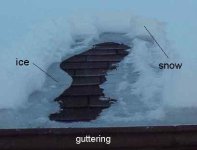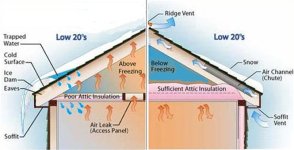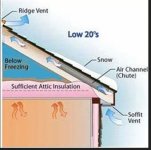SandburRanch
Veteran Member
- Joined
- Oct 12, 2010
- Messages
- 1,543
- Tractor
- NHtd75
Those with snow remaining on the roof probably have a type of ice dam, very little is known about, and water is entering the walls of the structure. In this case on my house, the complete roof had a layer of water under an eighth inch layer of ice topped by a foot of snow. The water at the walls had head pressure ( about 6' ) from the building line to the ridge. As soon as the ice was broken from the eave to the building line in a 2inch wide area, the head pressure was relieved and water ceased dripping from the windows.
More insulation may lower your heating bill but it doesn't prevent ice dams and water entering the walls. But it will change when it occurs as the outdoor ambient temperature changes.
More insulation may lower your heating bill but it doesn't prevent ice dams and water entering the walls. But it will change when it occurs as the outdoor ambient temperature changes.


